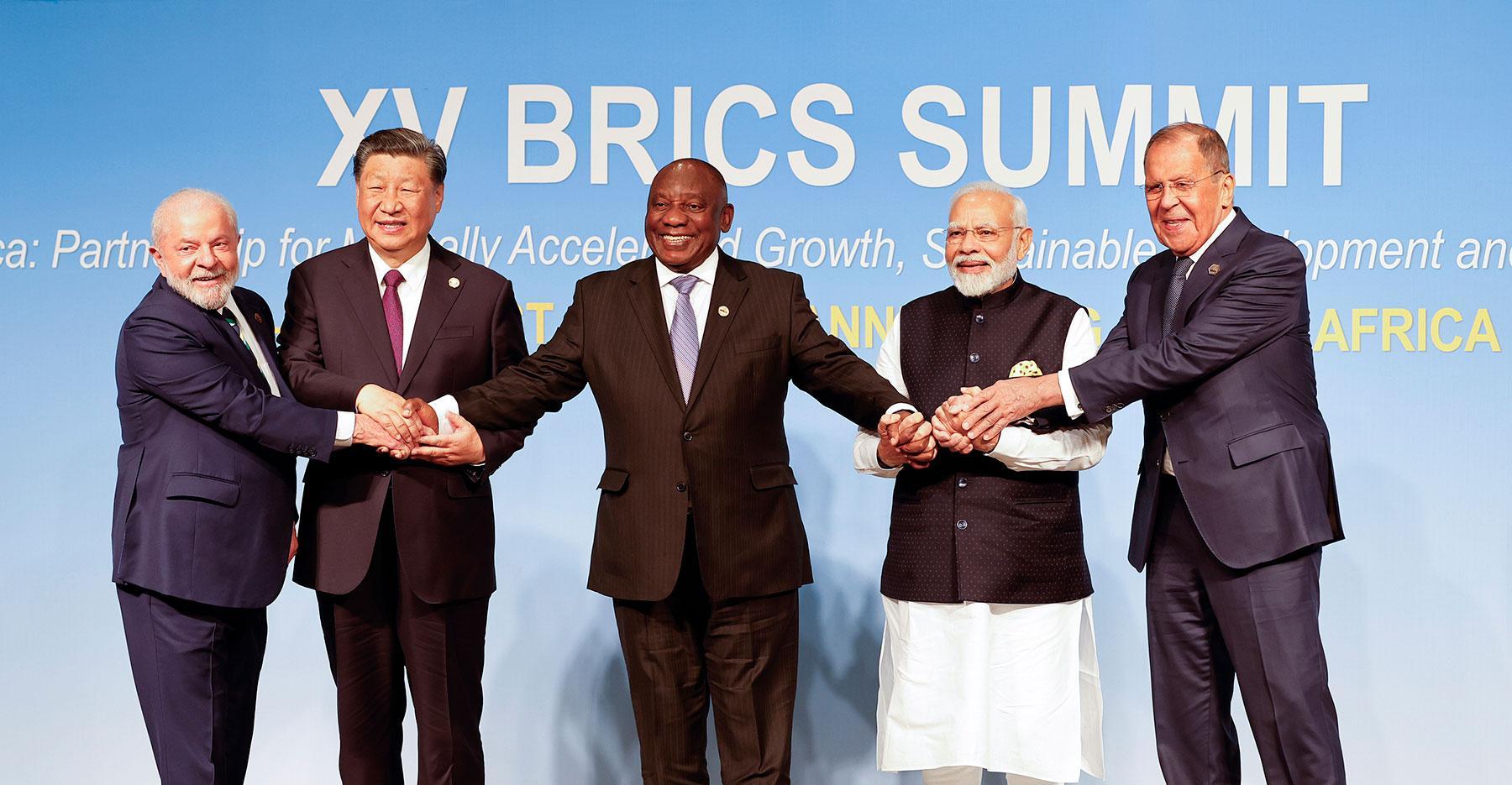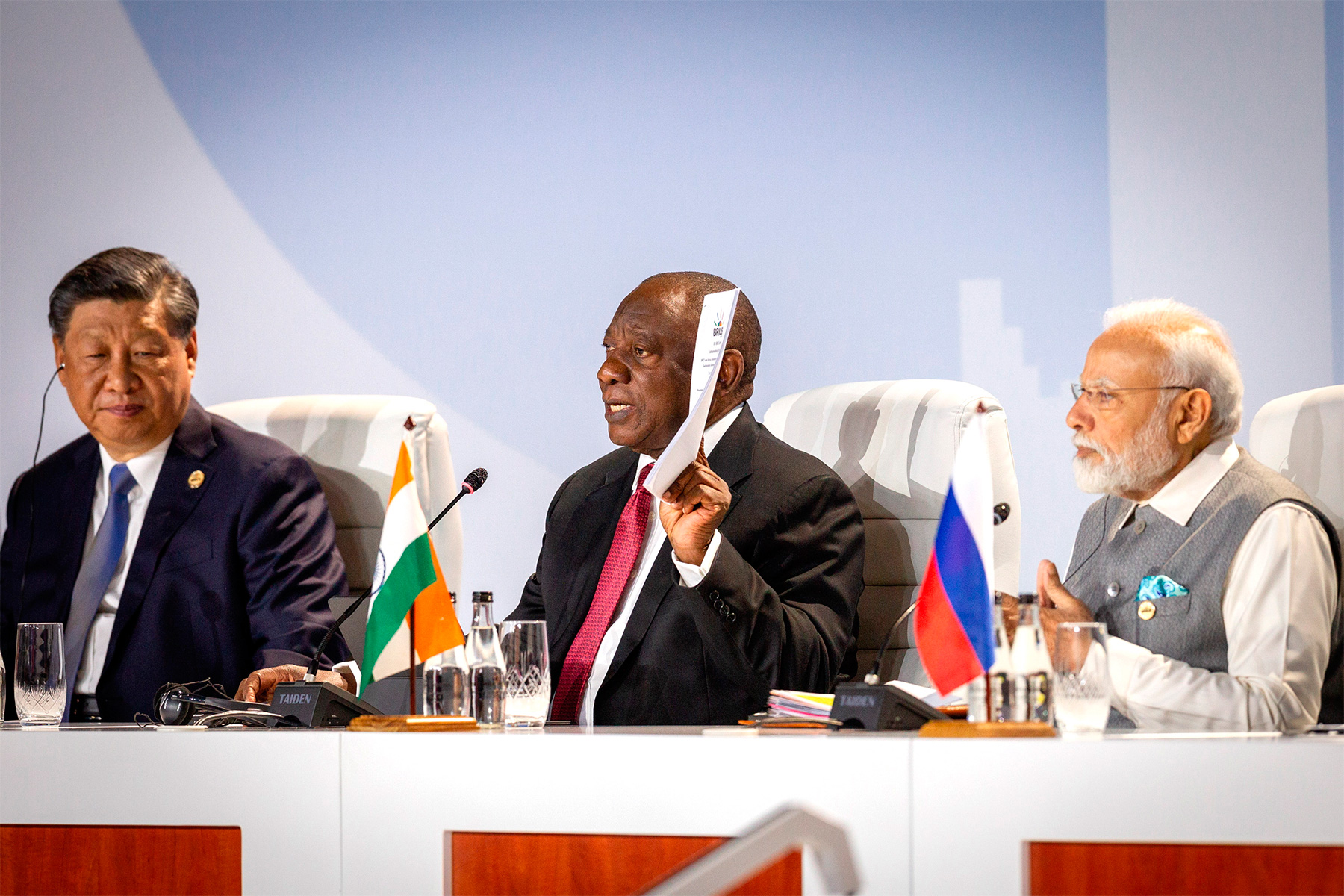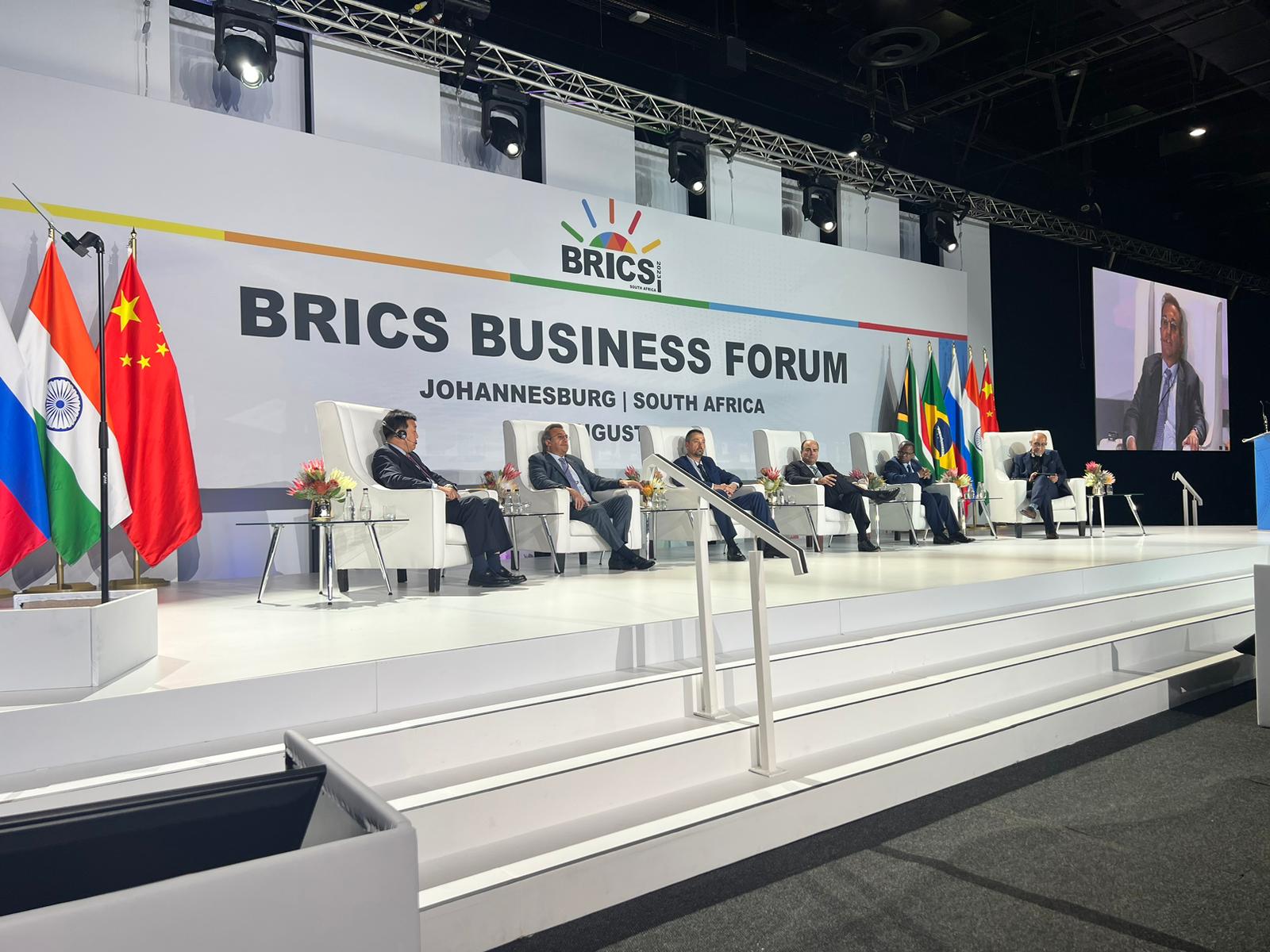The role of BRICS in the global economy is currently limited mainly to the production of strategic raw materials, low and medium value-added manufacturing goods as well as to providing transnational businesses with cheap labor. The global financial system is still leveraged by a coalition of developed nations led by the United States. Under the current monetary standard, the nations of BRICS do not receive adequate financial compensation that would correspond to their contribution to the real sector in global economy. Given the established rules of the international foreign exchange and credit markets, BRICS are, in fact, deprived of the possibility to make settlements and payments in their own currencies in the jurisdictions under their control. Essentially, their role in the global financial system is reduced to buying low-yielding bonds of developed nations as a key reserve asset. Meanwhile, Western countries have exhausted the possibilities of productive use of “excessive” financial resources accumulated in emerging markets, which leads to the growth of global debt and inflation.
The use of the U.S. dollar as a key reserve currency begets a configuration of international settlements, where BRICS, seeking access to international liquidity, are forced to produce a certain amount of goods for the external market in excess of what is actually needed by their economies, which is often accompanied by a devaluation of national currencies to ensure their international competitiveness. Such “overproduction” often draws financial and other resources from other national industries, putting the economy in a long-term dependence on the priority development of the export sector to the detriment of the national monetary unit stability as well as of other strategically important national industries.
To overcome these imbalances, the nations of BRICS will have to develop such a system of mutual multilateral settlements that will make it possible to channel international financial flows toward priority industries at the interregional level, which will smooth out structural imbalances as a cause of chronic lagging behind the leading group of the industrially developed nations as in their socio-economic development. Obviously, this is the only way to eliminate the G7’s monopoly in global financial flows and create real conditions for a stronger competitive position of BRICS in the global financial system.
The nations of BRICS have repeatedly called for the enhancement of their role and status within the current global financial system, which was long overdue. In this vein, the declaration of the 11th Brazil Summit held in November 2019 expressed disappointment of BRICS leaders with the results of the 15th General Review of IMF quotas, which failed to ramp up the total voting power of BRICS in the Fund. The five nations also declared their support for cooperation in the development of bond markets in BRICS national currencies, in a bid to increase their financial security profile amid unpredictable developments in the global financial environment.
Adopted on August 23, 2023, the Declaration of the 15th BRICS Summit on the admission of six new members to the group (Argentina, Egypt, Ethiopia, Iran, Saudi Arabia and UAE) is intended to strengthen cooperation among BRICS in the domain of international finance. In particular, it is about fostering further dialogue on payment instruments to facilitate trade and investment flows between the BRICS members as well as among other developing nations. The Parties called for more robust correspondent banking networks among the BRICS nations as well as for making settlements in local currencies possible.
In anticipation of the next BRICS summits to be held under the chairmanship of Russia in 2024 and Brazil in 2025, experts hope that BRICS will work together toward effective multilateral mechanisms for mutual settlements and payments. For example, former IMF executive director and former vice president of the New Development Bank, Brazilian economist Paulo Nogueira Batista Jr., does not rule out the possibility of a common BRICS currency and it being presented at the next year’s summit in Russia.4
A Bit of Background
It has been 22 years since James O’Neill, the newly elected head of global economic research at Goldman Sachs investment bank, introduced the acronym of BRIC. With this neologism, the British economist hoped to draw investors’ attention to the economic potential of four fast-growing emerging markets – Brazil, Russia, India and China. In his provocative publication titled Building Better Global Economic BRICs, O’Neill proposed to transform the Group of Seven (G7) into the Group of Nine (G9) by excluding two of the three Eurozone representatives and including the BRIC nations instead. The Asian financial crisis of 1997 and Russia’s default in 1998 (commonly associated with the notorious collapse of the American fund LTCM) objectively required new approaches to regulating the international movement of capital and the exchange rate for the leading reserve currencies. O’Neill argued that having the most dynamically developing economies on the influential advisory panel of developed nations could contribute to more balanced decisions in international economic policy. However, the G7 seemed unprepared for such radical reforms, sticking to its composition as it was. As a compromise, the Group of Twenty (G20) was later established, with the emerging market economies involved. Meanwhile, G20’s real potential to influence the transformation of international financial architecture has been questionable so far as global institutions with operational capacity—the IMF, the World Bank, the Bank for International Settlements, the Financial Stability Board—do not make any shifting moves without the G7 approval.
As for BRICS, after its enlargement through the expansion up to eleven member states, this grouping has bolstered its influence on three continents. Today, BRICS-11 accounts for 44% of global oil production and consumption, 36% of gas production and consumption, 70% of steel production and 65% of steel consumption, 44% of fertilizer production and 46% of fertilizer consumption, 57% of food production and consumption, and 48% of automobile production. Despite an impressive share in the international division of labor, the role of the BRICS nations in the global financial system remains quite insignificant since key instruments and institutions are still under the control of the U.S. and its allies. The U.S. dollar continues to play a major role in pricing on the global currency and credit markets, as well as acting as the main currency for invoicing in international trade, nominating international securities, and forming official foreign exchange reserves. The ability of sovereign and corporate borrowers to raise financial resources in international capital markets continues to depend, as was before, on the opinion of the three U.S. credit rating agencies. The U.S. retains its veto power in the Bretton Woods institutions, exerting enormous political influence on the international settlement and payment systems.
What are the chances of BRICS, under the current circumstances, to take a place in the global financial system that would correspond to their contribution to the real sector of the world economy? To answer this question, we need to consider the grouping’s current positioning in global finance.
Foreign exchange markets
The international foreign exchange market (FOREX) is the backbone of the global financial system. It is here that the virtual value of world currencies as key reserve assets is determined based on exchange quotations. As reported by the Bank for International Settlements, the daily turnover at FOREX exceeded USD 7.5 trillion in April 2022. The share of the U.S. dollar in the structure of foreign exchange trading amounted to 88%, whereas the combined share of BRICS-11 currencies was only 9%. Geographically, the UK and the U.S. accounted for 57.6% of trading, while the BRICS-11 – for only 3.2%.
The international foreign exchange market is an oligopoly of U.S. banks, which serviced 38.15% of total international foreign exchange trade in 2022.9 Over 70% of all FOREX transactions globally were conducted through the U.S.-controlled Continuous Linked Settlement (CLS).
As the world’s largest clearing system, CLS eliminates the risks of non-payment by counterparties on concluded currency transactions. Supposedly, the inclusion of national currency in the list of CLS currencies is one of the markers of its reliability for investors. Of the BRICS-11 currencies, only the South African rand enjoys this privilege. Currently, CLS conducts operations with 18 currencies, including such exotic ones as the Hungarian forint and the Israeli new shekel, whose shares on FOREX are much lower than those of the Chinese RMB, the Indian rupee, the Brazilian real and the Russian ruble. Nevertheless, the currencies of these leading BRICS nations continue to be overlooked by the global dealer banks that are major CLS shareholders. This is a significant obstacle to BRICS attaining more prominent positions in the international FX market.
Credit markets
Although the international credit market is much smaller in volume than the international FX market, it is an important indicator of a country’s participation in the redistribution of global financial resources and, consequently, of its role in global financial intermediation. Only China has so far made significant progress in this segment among the BRICS-11. According to the British TheCityUK, the size of China’s total banking assets (USD 61.7 trillion) in Q2 of 2022 was almost three times higher than that of the U.S. (USD 22.8 trillion) and five times higher than that of the UK (USD 12.4 trillion). That said, the UK accounted for 15% of international bank loans, the U.S. had a share of 9%, while that of China was only 4.3%. The dominant role of the UK in the international credit market is due to London’s status as a global center for foreign banks, of which 180 place their subsidiaries or branches here, which is virtually half of the UK banking sector’s revenues.
Despite the growing number of foreign banks with a business license in China, their expansion is constrained by current capital account restrictions, the scarcity of unoccupied niches in a market tightly controlled by local Chinese banks, sudden regulatory changes and government interventions. With the consistently high interest of foreign banks in the Chinese market, the share of their total assets in the Chinese banking system has still declined from the 2.3% peak in 2007 to 1.4% at the end of 2021, due to, among other things, the COVID pandemic and the strained diplomatic relations between Beijing and Washington.
The share of RMB in denominating internationally-traded debt securities remains extremely low as well. In Q4 of 2022, it stood at only 0.7%, while the share of the U.S. dollar was as high as 65.5%. China is still the second (next to Japan) largest overseas investor in U.S. government bonds, although the latter have contracted in the China’s portfolio from USD 1,121 billion in March 2019 to USD 859 billion in January 2023.
RMB’s internationalization through the international credit market could be facilitated by the issuance of panda bonds, which are RMB-denominated debt securities of foreign issuers quoted and traded in the domestic market of mainland China. Deutsche Bank suggests that the issuance of panda bonds in Q1 of 2023 reached a record high of RMB 72 billion (USD 10 billion), up 33% year-on-year.16
America’s Big Three credit rating agencies (S&P Global Ratings, Moody’s, Fitch) play an important role in the international credit market, wielding much influence on the cost of financial resources for various categories of corporate and sovereign borrowers. The methodology of rating assignment, used by the Big Three, has repeatedly subject to criticism due to conflicting interests and information asymmetries. The failed attempt to establish BRICS’ own credit rating agency has demonstrated the limited ability of the five nations to influence the entrenched order in the international credit rating market. In 2013, the Russian Rus-Rating agency in cooperation with China’s Dagong and the U.S. rating company Egan Jones founded an experimental international rating agency in Hong Kong, the Universal Credit Rating Group. The task was to offer a prototype of the new international rating system to ensure safer development by providing the global financial community with reliable rating information. However, the project was suspended due to disagreements between the Russian and Chinese rating agencies and their national regulators.18
Another factor constraining China’s growing influence in the international credit market could be the country’s declining involvement in financing of large-scale projects in emerging markets within the Belt and Road Initiative (BRI) on continents such as Africa, Asia, and Latin America. According to Foreign Affairs, during the first five years of the BRI’s operation, China’s spending on overseas transportation and energy infrastructure doubled that of the U.S., peaking at USD 120 billion. That was in 2016. However, between 2016 and 2019, China’s sovereign commitments of lending to BRI projects fell by 94% to a mere USD 3.9 billion. The curtailment of China’s lending activities in emerging markets was a deliberate decision taken by the Chinese government, largely due to the inefficient use or misuse of the funds provided, caused by persistent corruption in the governments of host economies and a weak market demand for the completed projects.
The slowdown of China’s activity in the financing of strategic infrastructure in developing markets potentially means that they remain dependent on credit from the U.S. and other developed nations of the West, which potentially lowers the status of China and other BRICS member states as international lenders.
Payment Systems
The BRICS-11 accounted for 22.0% of global exports of goods and services in 2022. However, most settlements in international trade are made in the G7 currencies through the SWIFT interbank system. SWIFT members are more than 11,000 banks from 200 countries, including 300 credit institutions from Russia. The majority of SWIFT transactions are made in U.S. dollars, euros and pounds sterling. In September 2023, the shares of the three currencies stood at 45.58%, 23.6% and 7.32% respectively. The RMB was only the fifth most popular payment currency on this network (3.71%) right below the Japanese yen (4.2%). However, 84.02% of international transactions in RMB are conducted through offshore banks in Hong Kong, the UK and Singapore. Among the BRICS-11 countries, only Russian banks supported settlements in RMB, which accounted for 1.9% of all transactions.
Some optimism is inspired by the fact that in the market of trade finance and settlements via SWIFT the RMB ranked second with a share of 5.8% (the share of the US dollar stood at 84.15%, euro – at 5.43%). Trade financing is a set of financial instruments such as a letter of credit, export credit or insurance coverage that enable an importer to obtain a deferred payment for goods. However, the size of the global trade financing market is small. For example, in 2022, it was estimated at USD 48.2 billion, which corresponds to only 0.03% of the total amount of payments serviced via SWIFT.
Tellingly, final settlements (clearing) of transactions, with information thereon transmitted via SWIFT, are carried out through payment systems much larger in volume than SWIFT. For example, the U.S. Clearing House Interbank Payment System (CHIPS), owned by leading U.S., European and Japanese banks supports the majority of cross-border dollar payments. In 2021 alone, settlements were made for transactions USD 407 trillion worth. The TARGET2 payment system, operated by the European Central Bank, supported transactions more than EUR 466 trillion (about USD 520 trillion) worth in 2020. In 2021, Chinese payment systems (HVPS, BEPS, IBPS, CFXPS, CIPS, etc.) processed a total of RMB 9.5 quadrillion (about USD 1,500 trillion) worth of payment transactions. These systems have internal messaging systems to facilitate non-SWIFT payments, but most of the large international payments are linked to SWIFT financial messages. In 2020, USD 140 trillion worth of financial messages were broadcast through SWIFT to make payments. By comparison, less than 0.5% of SWIFT’s transaction volume passed through China’s Cross-border Interbank Payment System (CIPS), the rest of the volume fell to the share of offshore banks.
Therefore, the real independence of BRICS from the international payment infrastructure controlled by the West can only be ensured by their own system of multilateral settlements in national currencies. Since 2018, a prototype of such a system has been developed under the BRICS PAY venture project, which combines the advantages of traditional payment systems with new technologies such as central bank digital currencies, decentralized financing and tokenized assets.
Currently, external settlements between BRICS member states still require conversion into U.S. dollars involving U.S. banks. For example, RMB-RUB cashless settlement using China’s UnionPay payment system cannot occur directly, as conversion into U.S. dollars is needed first. Therefore, the primary objective of the BRICS multilateral settlement system is to enable direct exchange of national currencies for external payments.
Conclusion
The role of BRICS in the global economy is currently limited mainly to the production of strategic raw materials, low and medium value-added manufacturing goods as well as to providing transnational businesses with cheap labor. The global financial system is still leveraged by a coalition of developed nations led by the United States. Under the current monetary standard, the nations of BRICS do not receive adequate financial compensation that would correspond to their contribution to the real sector in global economy. Given the established rules of the international foreign exchange and credit markets, BRICS are, in fact, deprived of the possibility to make settlements and payments in their own currencies in the jurisdictions under their control. Essentially, their role in the global financial system is reduced to buying low-yielding bonds of developed nations as a key reserve asset. Meanwhile, Western countries have exhausted the possibilities of productive use of “excessive” financial resources accumulated in emerging markets, which leads to the growth of global debt and inflation.
The use of the U.S. dollar as a key reserve currency begets a configuration of international settlements, where BRICS, seeking access to international liquidity, are forced to produce a certain amount of goods for the external market in excess of what is actually needed by their economies, which is often accompanied by a devaluation of national currencies to ensure their international competitiveness. Such “overproduction” often draws financial and other resources from other national industries, putting the economy in a long-term dependence on the priority development of the export sector to the detriment of the national monetary unit stability as well as of other strategically important national industries.
To overcome these imbalances, the nations of BRICS will have to develop such a system of mutual multilateral settlements that will make it possible to channel international financial flows toward priority industries at the interregional level, which will smooth out structural imbalances as a cause of chronic lagging behind the leading group of the industrially developed nations as in their socio-economic development. Obviously, this is the only way to eliminate the G7’s monopoly in global financial flows and create real conditions for a stronger competitive position of BRICS in the global financial system.







